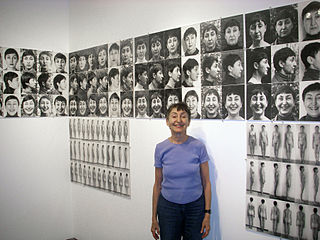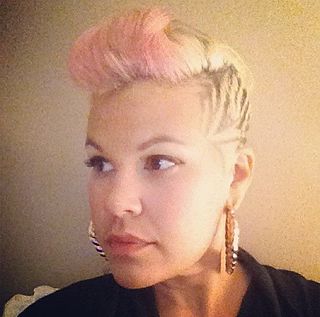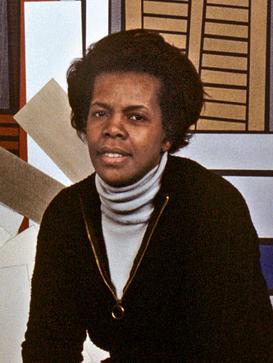Related Research Articles

Catherine Sue Opie is an American fine art photographer and educator. She lives and works in Los Angeles, as a professor of photography at the University of California, Los Angeles.
Jaune Quick-to-See Smith is a Native American visual artist and curator. She is an enrolled member of the Confederated Salish and Kootenai Tribes and is also of Métis and Shoshone descent. She is an educator, storyteller, art advocate, and political activist. Over the course of her five-decade long career, Smith has gained a reputation for her prolific work, being featured in over 90 solo exhibitions, curating over 30 exhibitions, and lecturing at approximately 200 museums, universities, and conferences. Her work draws from a Native worldview and comments on American Indian identity, histories of oppression, and environmental issues.
Kysa Johnson is a contemporary artist whose drawings, paintings, and installations explore patterns in nature that exist at the extremes of scale. Using the shapes of subatomic decay patterns, maps of the universe, or the molecular structure of pollutants or of diseases and cures – in short, microscopic or macroscopic “landscapes” – Johnson's work depicts a physical reality that is invisible to the naked eye. Often these micro patterns are built up to form compositions that relate to them conceptually.. Johnson graduated with honors from the Glasgow School of Art in Glasgow, Scotland. She has exhibited at, among other venues, The Aldrich Museum of Contemporary Art, The Tang Museum, The DeCordova Museum, Dublin Contemporary, The Nicolaysen Museum, The Katonah Museum of Art, The Hudson River Museum, The 2nd Biennial of the Canary Islands, The National Academy of Science, Morgan Lehman Gallery, Von Lintel Gallery, and Halsey McKay. Her work has been written about extensively in publications including Artforum, The New York Times, Interview Magazine, and The San Francisco Chronicle. Her work is included in many public collections including MIT, Microsoft, The Progressive Collection, Deutsche Bank, and Credit Suisse. She is a NYFA fellow (2003) and Pollock Krasner Grant recipient (2010).

Teresita Fernández is a New York-based visual artist best known for her public sculptures and unconventional use of materials. Her work is characterized by a reconsideration of landscape and issues of visibility. Fernández’s practice generates psychological topographies that prompt the subjective reshaping of spatial and historical awareness. Her experiential, large-scale works are often inspired by natural landscapes, investigating the historical, geological, and anthropological realms in flux. Her sculptures present optical illusions and evoke natural phenomena, land formations, and water.

Pat Steir is an American painter and printmaker. Her early work was loosely associated with conceptual art and minimalism, however, she is best known for her abstract dripped, splashed and poured "Waterfall" paintings, which she started in the 1980s, and for her later site-specific wall drawings.
Kay WalkingStick is a Native American landscape artist and a member of the Cherokee Nation. Her later landscape paintings, executed in oil paint on wood panels often include patterns based on Southwest American Indian rugs, pottery, and other artworks.

Athena Tacha, is a multimedia visual artist. She is best known for her work in the fields of environmental public sculpture and conceptual art. She also worked in a wide array of materials including stone, brick, steel, water, plants, and L.E.D. lighting. photography, film, and artists’ books. Tacha's work focused on personal narratives, and often plays with geometry and form.
Janise Yntema is an American painter working in the ancient wax encaustic technique. Yntema was born in New Jersey and attended Parsons School of Design and the Art Students League of New York. She has had solo exhibitions in New York and throughout the United States as well as London, Amsterdam and Brussels. Her works are in the collections of several museums in Europe and the United States, including the Museum of Modern Art and Metropolitan Museum of Art.

Heather T. Hart is an American visual artist who works in a variety of media including interactive and participatory Installation art, drawing, collage, and painting. She is a co-founder of the Black Lunch Table Project, which includes a Wikipedia initiative focused on addressing diversity representation in the arts on Wikipedia.

Michelle Lopez is an American sculptor and installation artist, whose work incorporates divergent industrial materials to critique present day cultural phenomena. She lives and works in Philadelphia, PA.
Martha Jackson Jarvis is an American artist known for her mixed-media installations that explore aspects of African, African American, and Native American spirituality, ecological concerns, and the role of women in preserving indigenous cultures. Her installations are composed using a variety of natural materials including terracotta, sand, copper, recycled stone, glass, wood, and coal. Her sculptures and installations are often site-specific, designed to interact with their surroundings and create a sense of place. Her works often focus on the history and culture of African Americans in the southern United States. In her exhibition at the Corcoran, Jarvis featured over 100 big collard green leaves, numerous carp, and a live Potomac catfish.

Mary Miss is an American artist and designer. Her work has crossed boundaries between architecture, landscape architecture, engineering and urban design. Her installations are collaborative in nature: she has worked with scientists, historians, designers, and public administrators. She is primarily interested in how to engage the public in decoding their surrounding environment.

Aiko Miyawaki was a Japanese sculptor and painter. She was best known for her sculpture series titled Utsurohi, installed at public spaces worldwide.

Dame Robin Adair White is a New Zealand painter and printmaker, recognised as a key figure in the regionalist movement of 20th-century New Zealand art.
Dyani White Hawk is a contemporary artist and curator of Sicangu Lakota, German, and Welsh ancestry based out of Minnesota. From 2010 to 2015, White Hawk was a curator for the Minneapolis gallery All My Relations. As an artist, White Hawk's work aesthetic is characterized by a combination of modern abstract painting and traditional Lakota art. White Hawk's pieces reflect both her Western, American upbringing and her indigenous ancestors mediums and modes for creating visual art.

Elia Alba (1962) was born in Brooklyn, New York. She is a multidisciplinary artist who lives and works in Queens, New York. Alba's ongoing project The Supper Club depicts contemporary artists of color in portraits, and presents dinners where a diverse array of artists, curators, historians and collectors address topics related to people of color and to women.

Jodie Lyn-Kee-Chow is an American interdisciplinary artist based in New York City. She is best known for her work in performance art. She teaches at the School of Visual Arts, and is a mentor in the New York Foundation for the Arts' Immigrant Artist Mentoring Program.

Mavis Iona Pusey was a Jamaican-born American abstract artist. She was a printmaker and painter who was well known for her hard-edge, nonrepresentational images. Pusey drew inspirations from urban construction. She was a leading abstractionist and made works inspired by the constantly changing landscape.
Anna Tsouhlarakis is a Native American artist who creates installation, video, and performance art. She is an enrolled citizen of the Navajo Nation and of Muscogee Creek and Greek descent. Her work has been described as breaking stereotypes surrounding Native Americans and provoking thought, rather than focusing solely on aesthetics. Tsouhlarakis wants to redefine what Native American art means and its many possibilities. She also works at the University of Colorado Boulder as an Assistant professor.

Charlotte Schulz is an American visual artist best known for intricate charcoal drawings, sometimes composed of multiple sheets that she tears, folds and distresses in order to disrupt the two-dimensional picture plane. Her work explores personal and collective responses to traumatic, often-public, experiences and events, interweaving vignettes of landscape, interiors, disasters and unexpected elements in dreamlike combinations that upend spatial and temporal conventions. Artillery critic Seph Rodney describes her drawings as works of "elegant and surreal lyricism" that are exquisitely rendered, thick with detail, and perplexing in their mix of fractured visual logic, overlapping realities, and speculative ruminations on space and time.
References
- 1 2 "Athena LaTocha: The Presence of Monumentality". NMAI Magazine. Retrieved 2023-10-20.
- ↑ Abatemarco, Michael (2017-01-27). "MoCNA — Athena LaTocha: "Inside the Forces of Nature"". Santa Fe New Mexican. Retrieved 2023-10-20.
- ↑ "BIOGRAPHY". athenalatocha.com. Retrieved 2023-10-20.
- ↑ "Flowing Through the Ice House". The Highlands Current. 2019-05-12. Retrieved 2019-11-19.
- 1 2 3 "Artists warm to winter workspace". The Riverdale Press. 2 March 2018. Retrieved 2019-11-21.
- ↑ "Visiting Artist Series". Maine College of Art & Design. Retrieved 2023-10-20.
- ↑ "Athena LaTocha". Plains Art Museum. Retrieved 2021-03-10.
- ↑ Moustakas, Tiffany (2018-03-02). "Artists warm to winter workspace". The Riverdale Press. Retrieved 2023-10-20.
- 1 2 3 Besaw, Mindy N. (October 2018). Art for a new understanding : native voices, 1950s to now. Hopkins, Candice., Well-Off-Man, Manuela. Fayetteville, NC. ISBN 9781610756549. OCLC 1059450735.
{{cite book}}: CS1 maint: location missing publisher (link) - 1 2 Abatemarco, Michael (27 January 2017). "MoCNA – Athena LaTocha: "Inside the Forces of Nature"". Santa Fe New Mexican. Retrieved 2019-11-21.
- ↑ "Liveable Worlds". Institute of Contemporary Art. Retrieved 2023-10-20.
- ↑ "Exhibition 2023 Art on Paper". Weatherspoon Art Museum. Retrieved 2023-10-20.
- ↑ "Athena LaTocha: The Past Never Sleeps - Exhibitions". 2022-06-16. Retrieved 2023-10-20.
- ↑ "The Land Carries Our Ancestors: Contemporary Art by Native Americans". National Gallery of Art. Retrieved 2023-10-20.
- ↑ "Athena LaTocha". CUE Art Foundation. Retrieved 2021-03-10.
- ↑ Green, Christopher (2019-02-01). "Beyond Inclusion". ARTnews.com. Retrieved 2021-03-10.
- ↑ The Village Sun website
- ↑ Durón, Maximilíano (2023-12-14). "Anonymous Was A Woman Names 2023 Winners, Including Artists Dindga McCannon, Carolina Caycedo, Barbara Kasten, Amanda Ross-Ho". ARTnews.com. Retrieved 2023-12-24.
- ↑ "The Pocantico Prize". Rockefeller Brothers Fund. Retrieved 2023-10-20.
- ↑ "Meet 2021 Fellowship Artist: Athena LaTocha". Eiteljorg Museum. 2021-10-13. Retrieved 2023-10-20.
- ↑ "Introducing | 2021 NYSCA/NYFA Artist Fellows, Finalists, and Panelists". NYFA. 2021-07-13. Retrieved 2023-10-20.
- ↑ "Athena LaTocha". Joan Mitchell Foundation. 2019-01-10. Retrieved 2023-10-20.
- ↑ "Past Residents Captiva". Robert Rauschenberg Foundation. Retrieved 2023-10-20.